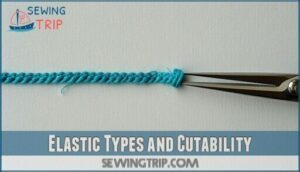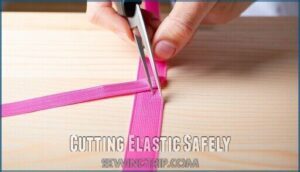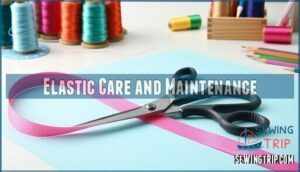This site is supported by our readers. We may earn a commission, at no cost to you, if you purchase through links.

Start by checking the type of elastic. Braided elastic loses stretch and frays easily if cut, making it unsuitable. Knitted elastic is more forgiving and stays functional when trimmed.
Woven elastic, though durable, can also fray, so caution is key. Use sharp scissors or a rotary cutter for clean edges.
To prevent fraying, seal the cut edges with liquid fabric stabilizer, a zigzag stitch, or by lightly melting synthetic materials. Cutting elastic effectively depends on its type and your method. A little planning saves frustration later!
Table Of Contents
- Key Takeaways
- Cutting Elastic Basics
- Can You Cut Elastic Lengthwise
- Elastic Types and Cutability
- Preventing Elastic Fraying
- Cutting Elastic Safely
- Elastic Widths and Applications
- Cutting Thick Elastic Strips
- Elastic Care and Maintenance
- Choosing Right Elastic Type
- Advanced Elastic Cutting Techniques
- Frequently Asked Questions (FAQs)
- Conclusion
Key Takeaways
- Always check the elastic type before cutting. Knitted elastic is the best option to cut lengthwise because it resists fraying, while braided and woven elastic tend to unravel.
- Use sharp scissors or a rotary cutter for precise cuts. This ensures clean edges and avoids weakening the elastic.
- Prevent fraying by sealing the edges with liquid fabric stabilizer, using a zigzag stitch, or melting synthetic materials.
- Cutting elastic lengthwise is not ideal for loosening it. Instead, choose a softer elastic for better fit and flexibility.
Cutting Elastic Basics
Cutting elastic requires understanding its different types and how they behave. Knowing these basics helps you choose the right cutting techniques and avoid weakening the material.
Master the art of cutting elastic by understanding its types, behaviors, and techniques to maintain strength and durability.
Types of Elastic
Understanding elastic types helps you choose the right one.
Braided elastic is strong but narrows when stretched. Knitted elastic is soft, staying wide under tension. Woven elastic is firm and ideal for heavy fabrics.
Clear elastic is lightweight and stretchy, while buttonhole elastic offers adjustability.
Elastic fabric types often include spandex blends for enhanced stretch and recovery. Each type suits specific needs, especially when planning to cut elastic lengthwise using proper techniques to achieve proper techniques.
Elastic Properties
Elastic properties determine how it performs when stretched, cut, or exposed to elements.
Fiber composition impacts durability and elasticity.
Stretch recovery maintains its shape and resilience, while elasticity guarantees flexibility.
Beware of chlorine sensitivity and heat resistance, as they weaken the material.
Cutting elastic lengthwise often compromises integrity, risking unraveling and width reduction, harming overall durability.
Common Uses of Elastic
You’ll find elastic used everywhere—waistband elastic gives skirts or pants a snug fit, while swimwear elastic keeps necklines and edges secure.
Sleeve elastic guarantees sleeves stay in place, and leg cuffs keep pants comfortable.
Even hair accessories like headbands rely on elastic. Whether altering or reducing elastic width, use elastic cutting techniques carefully to avoid weakening the material.
Can You Cut Elastic Lengthwise
Cutting elastic lengthwise can be tricky, and it’s not always recommended. Some elastic types lose their structure, affecting elasticity and durability. When you split an elastic band, you’re risking fraying, weakening, or even ruining the piece entirely.
Selecting the right elastic and using proper techniques are key to preserving elastic integrity and avoiding unnecessary material waste. Here’s what to keep in mind before you cut:
- Braided elastic frays easily and loses strength—don’t cut it.
- Knitted elastic is safer; it won’t unravel, making thin elastic strips easier to create.
- Woven elastic shouldn’t be divided; fraying risks are high.
- Fantastic Elastic handles cutting well, maintaining structure.
- Always test cutting on scraps to minimize cutting consequences.
Precision is vital for lasting results.
Elastic Types and Cutability
Not all elastic types can handle being cut lengthwise without issues. Understanding the cutability of braided, knitted, and woven elastic helps you choose the best option for your project.
Braided Elastic Cutability
Braided elastic isn’t suitable for cutting lengthwise.
It unravels quickly, compromising its strength and making it unreliable for casing applications.
Elastic fraying is a common issue with this type, making securing ends quite tricky.
If you need to cut elastic lengthwise, consider alternative elastics like knitted ones.
Avoid braided unraveling by choosing the right elastic for your project, to prevent unraveling.
Knitted Elastic Cutability
Knitted elastic is an excellent choice for elastic modification due to its knitted integrity and fray resistance.
Knitted elastic offers unmatched flexibility and fray resistance, making it perfect for precise modifications and durable, lasting results.
You can cut elastic lengthwise without affecting stretch retention, making it perfect for elastic cutting projects.
Its flexibility works in casings or direct applications.
Use careful cutting methods to maintain application suitability and guarantee precise edges, preventing potential elastic fraying during use, which relies on fray resistance and stretch retention.
Woven Elastic Cutability
Woven elastic isn’t ideal for cutting lengthwise. It frays easily, compromising its strength and causing elastic unraveling.
The tight weave construction makes woven width alteration tricky, reducing its durability. If trimming is necessary, take steps like these for elastic fraying solutions:
- Test a small section first.
- Use sharp scissors or a rotary cutter.
- Apply liquid stabilizers.
- Stitch edges securely.
Many stretchy fabrics utilize highly elastic elastane for enhanced flexibility, which is crucial for elastic fabrics to maintain their purpose.
Preventing Elastic Fraying
When you cut elastic, ensuring the edges don’t fray is key to maintaining its durability.
Simple methods like fabric stabilizers, zigzag stitching, or melting synthetic edges can help keep your projects neat and functional, with complete concepts being crucial for a successful outcome.
Using Liquid Fabric Stabilizer
When reducing elastic width or cutting elastic strips, stabilizer application helps prevent fraying.
Liquid fabric stabilizers temporarily stiffen edges, making elastic strip cutting smoother.
Apply evenly to the split elastic band, let it dry, and verify fabric compatibility.
Many crafters find fabric stabilizer products useful for these projects.
This antifray method maintains elasticity without long-term effects.
Rinse residue after sewing for a clean finish and reliable fraying prevention to ensure a clean finish.
Applying Zigzag Stitch
A zigzag stitch is your best friend for stopping elastic fraying.
Set the stitch width and length to medium for balanced coverage. Adjust tension settings to match the elastic type.
Use a ballpoint needle for elastic sewing to avoid damage. Test first on scraps to perfect results.
This method strengthens edges after cutting elastic lengthwise.
Melting Synthetic Edges
To prevent fraying after cutting elastic lengthwise, melting the edges works well for synthetic fibers.
Use a low flame or soldering iron as a safe elastic melting method. Keep flame height minimal to avoid damage.
Let melted edges cool completely before handling. This antifray method guarantees durability, especially for elastic width reduction projects, aligning with best practices and safety.
Cutting Elastic Safely
When cutting elastic, it’s important to use the right tools and techniques to maintain its strength and shape.
Sharp scissors or a rotary cutter, along with careful measuring, guarantee clean, precise cuts without wasting material, which helps in maintaining the elastic’s overall shape.
Using Sharp Scissors
To achieve cutting precision, use sharp scissors specifically designed for fabric.
Ergonomic scissors reduce hand fatigue, making them ideal for precise elastic cutting.
Blade types matter—choose ones with a fine edge for clean cuts.
Regular scissor maintenance, like sharpening, guarantees smooth results.
Consider purchasing specialized cutting implements for best results.
When cutting elastic lengthwise, sharp scissors prevent fraying, making them a must-have elastic cutting tool for every project that requires precise elastic cutting with a fine edge.
Using Rotary Cutter
A rotary cutter makes cutting elastic lengthwise precise and clean. Always check blade sharpness—dull blades snag or fray elastic.
Use a self-healing cutting mat for safety and accuracy. For a smooth cut, press firmly and glide along a straight edge.
Many sewers find a cutting mat indispensable for their projects. Fabric stabilizer assists in keeping edges intact. This tool is key for elastic sewing tips and detailed work.
Measuring Twice
An elastic cutting guide starts with accurate measurement. Double-checking measurements guarantees precision cutting while avoiding cutting errors.
It minimizes waste and produces straight cuts. Use elastic measurement tools like rulers or transparent cutting mats.
Mark the elastic with chalk or a pen for clear cutting lines. Careful preparation makes cutting elastic safer and more efficient with professional results.
The process relies on precise tools and techniques to ensure the best outcome, making cutting elastic a manageable task when done correctly.
Elastic Widths and Applications
Elastic comes in various widths, each suited for specific applications. Thinner elastic works well for necklines and swimwear, while wider options are ideal for waistbands and heavier fabrics.
Thin Elastic for Swimwear
Swimwear elastic is typically made from chlorine-resistant materials like clear or cotton elastic.
Thin elastic widths, ranging from 1/4 inch to 3/4 inch, provide flexibility and comfort for necklines and leg openings.
A narrow elastic band works best for lightweight fabrics, ensuring a secure fit.
Use elastic cutting tools carefully to maintain accuracy and preserve stitching techniques during sewing.
Wide Elastic for Waistbands
When choosing wide elastic for waistbands, the right elastic width guarantees durability, comfort, and stretch recovery.
Heavier fabrics need firm types, while lightweight ones pair with softer elastic.
- Widths of 1-2 inches work best for most elastic waistband projects.
- Use elastic cutting tools for neat trims before sewing.
- Apply proper application methods for secure results.
Elastic for Sleeves and Leg Cuffs
For sleeves and leg cuffs, the right elastic width boosts comfort and durability.
Use 1/8 to 1/2-inch elastic, balancing stretch factor and fabric weight.
Thin elastic works best for lightweight fabrics, while sturdier options suit denser materials.
Elastic alteration and cutting methods matter—opt for flexible types for easy sewing hacks.
Proper elastic for sleeves enhances movement, ensuring lasting fit.
Cutting Thick Elastic Strips
When cutting thick elastic strips, it’s important to use the right tools and techniques to maintain their integrity.
Choose elastic types like Fantastic Elastic or knitted elastic that handle cutting well without fraying or losing stretch.
Using Fantastic Elastic
Fantastic Elastic offers unmatched flexibility when trimming elastic bands.
With its fantastic durability and stretch, it’s made for elastic cutting methods that prevent fraying.
You can cut it to any elastic width, down to 1/4 inch, without compromising its strength.
Its best applications include waistbands, sleeves, and custom projects, eliminating the need for multiple width options.
Folding Fold-Over Elastic
Folding fold-over elastic is simple and versatile for edge finishes.
Fold it in half lengthwise and stitch along the edge to secure the fold.
It’s great for:
- Headbands and hair ties.
- Elastic sewing modifications like raw edge finishing.
- Best projects like lingerie or babywear.
- Adding decorative options with its shiny front.
- Testing elastic cutting methods for custom widths.
Cutting Knitted Elastic
Knitted elastic is perfect for cutting, thanks to its soft texture and ability to avoid fraying.
Use sharp scissors or a rotary cutter for clean edges. Stick to straight lines to prevent stretch issues, and cut to your desired elastic width with ease.
This cutting technique offers endless flexibility for projects requiring specific widths or innovative designs.
Elastic Care and Maintenance
Proper care extends elastic’s lifespan and keeps it functional for your projects. You should avoid heat, harsh chemicals, and improper storage to maintain its stretch and strength.
Washing and Drying Elastic
To maintain elastic durability, wash with cold water and gentle detergent.
Avoid hot water to prevent elastic shrinkage.
Handwashing is best, but a gentle cycle works too.
Skip machine drying—air drying preserves elasticity.
If you must, use tumble drying on a no-heat setting.
Proper elastic care guarantees longevity, reducing wear and maintaining stretch for long-term use.
Avoiding Chlorine and Heat
Chlorine degradation and heat sensitivity can weaken elastic, especially swimwear types.
Avoid exposure to high heat, like dryers, and chlorine-heavy pools.
Opt for elastic alternatives like cotton or clear elastic in swimwear for better longevity.
Material composition matters—choose elastic with chlorine resistance and heat resistance.
Proper care prevents damage, ensuring elastic retains its stretch and durability over time.
Storing Elastic Properly
Proper elastic storage preserves its quality.
Keep elastic in ideal conditions: moderate humidity, cool temperatures, and away from light exposure.
Store it rolled instead of folded to prevent creases that weaken its integrity.
Avoid damp areas to maintain elasticity.
Gentle handling protects against tears.
Smart elastic maintenance guarantees durability, making it last longer for all your sewing projects.
Choosing Right Elastic Type
Choosing the right elastic type guarantees your project looks great and functions well.
You’ll need to match the elastic’s stretch and durability to your fabric and specific needs for the best results.
Selecting Elastic for Project Needs
Choosing the right elastic can make or break your project.
Always consider:
- Elastic Types: Braided, knitted, or woven—it affects durability and stretch.
- Elastic Width: Match width with usage, like ¾" for waistbands.
- Fabric Weight: Lighter fabrics need softer options.
- Project Type: Swimwear or waistbands require specific elastics.
- Comfort Factors: Soft finishes work best for direct skin contact.
Considering Durability and Comfort
Balancing elastic durability and comfort begins with matching its stretch recovery and lifespan to your project.
Lightweight fabrics need soft, flexible options, while heavier materials require stronger, wider varieties for proper application tension.
Elastic integrity matters for skin sensitivity, so choose carefully.
For lasting results, prioritize elastic width and elasticity suited to the fabric weight and intended use, ensuring minimal fraying.
Choosing Elastic for Specific Fabrics
When picking elastic, fabric weight and garment type matter most.
Use these tips:
- Elastic Width: Wide elastic works best for waistbands; narrow elastic suits swimwear.
- Fabric Weight: Lightweight fabrics need soft knit elastic, heavier fabrics need woven elastic.
- Elastic Stretch: Choose elastic with enough stretch for flexibility.
- Color Matching: Match elastic color to fabric for seamless looks.
For activewear, consider options like spandex and blends.
Advanced Elastic Cutting Techniques
When cutting elastic lengthwise, using proper techniques helps maintain its strength and elasticity. Understanding the characteristics of different elastic types guarantees cleaner cuts and reduces material waste.
Cutting Elastic for Masks
When cutting elastic for masks, choose 1/8-inch to 1/4-inch widths for ear loops.
Knitted elastic works well since it resists fraying when cut.
Use sharp scissors for clean edges, and test a small piece first.
For elastic alternatives, consider cutting knit fabric strips as mask ties.
Attaching elastic directly guarantees even distribution.
Keep cuts precise to guarantee comfort and durability while wearing.
Cutting Braided Elastic Safely
Braided elastic frays easily, so you’ll need extra care when trimming it.
Avoid unraveling by using sharp scissors for clean cuts and sealing ends with liquid fabric stabilizer or zigzag stitching.
Melting synthetic edges gently works too.
If precision matters, try braided elastic alternatives like knitted types.
Securing braided ends prevents weakening, ensuring your project stays durable.
Cutting Woven Elastic With Precision
Woven elastic needs precision when cutting to prevent fraying and maintain width.
Using the right tools and methods makes all the difference.
- Use sharp cutting tools like scissors or a rotary cutter.
- Measure accurately with a ruler to guarantee straight edges.
- Apply zigzag stitches to secure ends.
- Try antifray methods like liquid stabilizer.
- Avoid cutting elastic lengthwise.
Frequently Asked Questions (FAQs)
How to cut elastic lengthwise?
When cutting elastic lengthwise, choose knit elastic since it won’t fray or lose stretch.
Avoid braided or woven types—they unravel easily.
Use sharp scissors, measure carefully, and test a small section first.
Can I cut an elastic in half?
You can cut some elastics, like knitted or "Fantastic Elastic," lengthwise without issues.
But others, like braided or woven elastic, will fray and lose strength.
Check the elastic’s type before cutting to prevent damage.
Can you cut elastic to make it looser?
You can’t loosen elastic by cutting it.
Elastic’s tension comes from its structure, so altering it weakens its stretch or ruins it entirely.
Instead, swap for a softer or wider elastic to fit your needs.
Does elastic fray when cut?
Elastic can fray when cut, depending on the type.
Woven elastic unravels quickly, while knitted elastic holds up better.
For clean cuts, test a small piece, and seal edges with stitching or fabric stabilizer to prevent fray.
Can you cut elastic to make it narrower?
You can cut knitted elastic to make it narrower since it won’t fray or lose strength.
However, braided and woven elastic aren’t ideal because cutting them lengthwise weakens their structure and causes fraying.
What tools are best for cutting elastic lengthwise?
Imagine slicing silk with precision!
Use sharp scissors or a rotary cutter paired with a straight edge for clean, accurate cuts.
A rotary cutter guarantees smooth edges, while scissors provide better control for detailed work.
What techniques can be used to prevent fraying when cutting elastic?
To prevent elastic from fraying, use zigzag stitching, apply liquid fabric stabilizer, or melt synthetic edges with a lighter.
Testing a small section first helps.
A sharp rotary cutter guarantees clean, precise cuts.
What types of elastic are best for sew-on applications?
Knitted elastic is your top pick for sew-on applications due to its soft texture and ability to maintain width under stretch.
Woven elastic also works well, offering a firmer hold for heavier fabrics.
Are all elastics suitable for swimwear?
Picture diving into crystal-clear waves.
Not all elastics can handle that plunge—polyester-based types break down in chlorine.
Choose chlorine-resistant options like clear or cotton elastic for swimwear.
They’re water-friendly, durable, and ready for adventure.
What is the difference between elastic widths?
Elastic widths vary by project needs.
Thinner ones, like 1/4-inch, work for necklines or swimwear. Wider options, up to 3 inches, suit waistbands or heavier fabrics.
Choosing the right width guarantees fit and function.
Conclusion
Knowing that cutting elastic in half lengthwise works best with certain types can save you time.
About 90% of elastic materials behave differently when cut, so always check if you’re using braided, knitted, or woven types.
To get the best results, use sharp tools, stabilize edges, and match your method to the elastic type.
Proper preparation prevents fraying and keeps the elastic functional.
With practice, you’ll know exactly how to handle elastic for your projects.
- https://amyssewingstudio.com/knit-elastic/
- https://www.elasticbytheyard.com/tips/
- https://totbabytalk.wordpress.com/2020/04/10/sewing-hacks-how-to-cut-elastic-lengthwise-no-unraveling/
- https://www.reddit.com/r/sewing/comments/fx9pim/is_there_a_way_to_cut_elastic_in_half_widthwise/
- https://en.wikipedia.org/wiki/Stretch_fabric
















